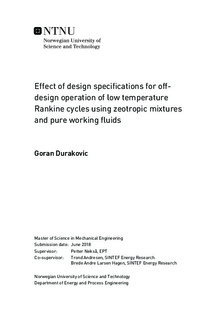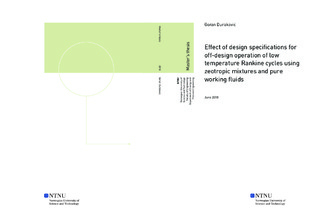| dc.description.abstract | Using organic Rankine cycles to produce power from low temperature heat sources seems like a promising solution to lower our reliance on environmentally damaging energy sources. By introducing this technology to new and existing industrial processes, it is possible to increase the energy efficiency of the industry, and thereby reduce their consumption of energy. In order to make the cycles' implementation more attractive to the industry, an analysis on their performance variation with the changing seasons must be conducted. The aim of this work is to evaluate the yearly performance of organic Rankine cycles using butane, pentane and a 50%-50% mixture of these as the working fluids, and gauge their sensitivities to their design specifications and conditions. This work is a continuation of a project work from the preceding fall, from which the three working fluids have been chosen to be investigated more deeply.
A literature study has been performed to identify the cycle components that play a key role in the off-design performance of the organic Rankine cycle, and to explore the influence of changing varying heat source and sink characteristics. Furthermore, a major focus in the literature study was to find the most appropriate expander technology for the pressure ratios and power outputs of the cycles in this work. To gauge the approximate values of these, the results from the project work were utilized. Ultimately, it was decided that screw expanders matched well with the needs of this cycle. Using models discovered in the literature study, an off-design model of the expander, which took into account non-design volumetric flows and pressure ratios, was developed and implemented.
With a working off-design model, a design point was chosen for each fluid and their yearly performance optimized. The off-design performance at each data point was compared with its corresponding on-design optimization, which has the optimal set of parameters for that data point. It became clear that pentane was much worse-performing than both butane and the mixture, and so the subsequent analyses favored these two working fluids, while pentane was neglected.
The chosen design points for butane and the mixture were evaluated on whether they were feasible operationally, and no problems were found. Afterwards, their performances were each compared with an alternative design point, which found that the original design points were thermodynamically better. Having accepted the original design points as optimal, the cycle was evaluated under different conditions to investigate how the off-design performance varied with such changes.
Because the model used in this work is unable to model the waste heat recovery unit, the temperature difference in this entire heat exchanger was set to 17.5 K. The influence of this choice was investigated by changing the temperature difference with +-7.5 K. Implicit in this is that the size of the waste heat recovery unit has changed: a larger temperature difference means a smaller waste heat recovery unit and vice versa. For butane, decreasing the temperature difference in the waste heat recovery unit from 25 K to 10 K increased the exergy efficiency of the cycle from 30.9% to 41.1%, while this increase was from 30.8% to 41.4% for the mixture. Having a non-constant temperature difference in the waste heat recovery unit was also investigated for the mixture. Using the data from the project work, the maximum and minimum temperature of the indirect water was set to the optimal solution found in those results. This did not perform better than the constant temperature difference of 17.5 K, primarily because of much more unused exergy being left in the heat source. The performance was estimated where there was no unused exergy left in the heat source, and this showed that the non-constant temperature difference performed better than the cycle with constant temperature difference.
District heating is part of the system, and the heat for this is extracted upstream of the organic Rankine cycle. The performance impact of this has been estimated, and it shows that if there were no district heating, the electric energy output could be increased with 15.1% for butane, and 19.3% for the mixture. However, despite the increased electric power output, it is not clear that this is economical, as the district heating accounts for roughly 60% of the yearly energy output -- when it is included. For it to be economical to neglect the district heating, it was calculated that the price of the district heat would have to be less than roughly 10% of the price of electricity. Other designs for extracting the district heat, where the high-temperature and low-temperature heat would be spent on power production, and medium-temperature heat would be dedicated to district heating, were also qualitatively discussed.
The effect of increasing the temperature of the heat source was also investigated, along with the response of increasing the allowable heat exchanger area for the evaporator, recuperator and condenser. Unlike with the waste heat recovery unit, the optimizer can modify the areas of these heat exchangers while optimizing, and choose the optimal distribution by itself. In increasing the temperature, the mass flow was reduced so that the heat content relative to the ambient was maintained. It was found that by just increasing the heat exchanger area from 230 m2 to 300 m2, the net power of butane would increase by 13% relative to the normal case, while the mixture would experience an increase of 17%. Increasing only the temperature from 150 C to 180 C increased the power for a cycle using butane with 43%, while the mixture increased its power output by 37%. Finally, increasing both simultaneously yielded a 63% increase for butane and 56% increase for the mixture. | |

